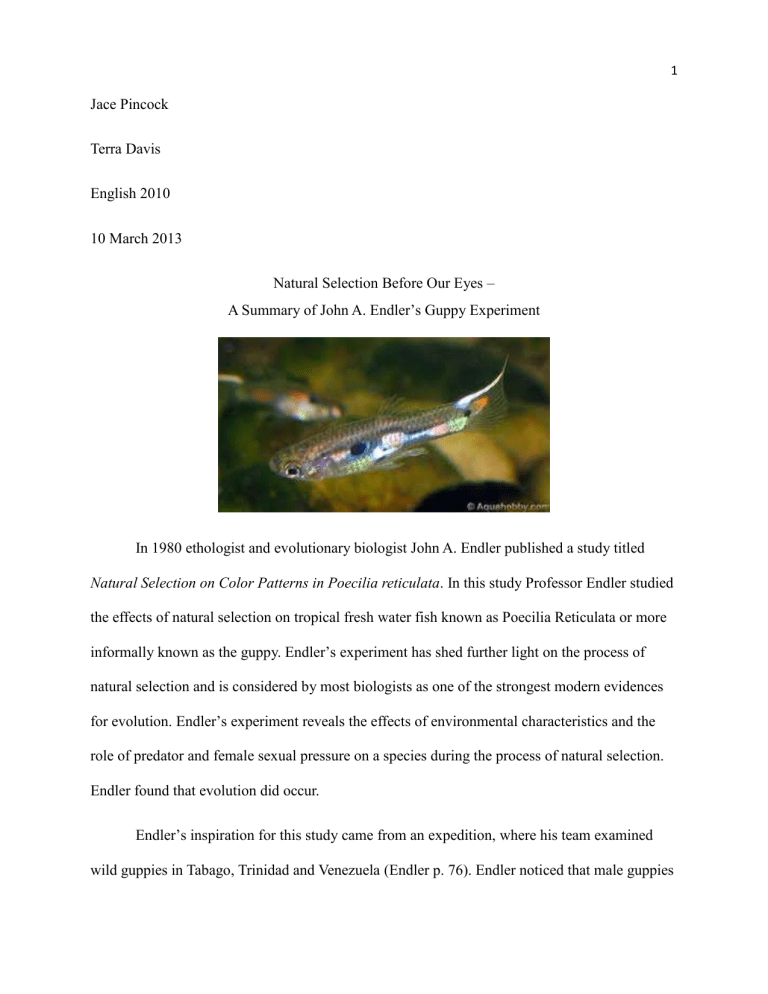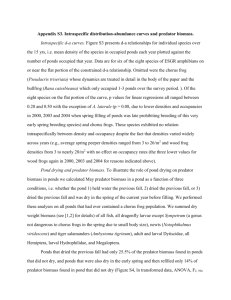File

Jace Pincock
Terra Davis
English 2010
10 March 2013
Natural Selection Before Our Eyes –
A Summary of John A. Endler’s Guppy Experiment
1
In 1980 ethologist and evolutionary biologist John A. Endler published a study titled
Natural Selection on Color Patterns in Poecilia reticulata . In this study Professor Endler studied the effects of natural selection on tropical fresh water fish known as Poecilia Reticulata or more informally known as the guppy. Endler’s experiment has shed further light on the process of natural selection and is considered by most biologists as one of the strongest modern evidences for evolution. Endler’s experiment reveals the effects of environmental characteristics and the role of predator and female sexual pressure on a species during the process of natural selection.
Endler found that evolution did occur.
Endler’s inspiration for this study came from an expedition, where his team examined wild guppies in Tabago, Trinidad and Venezuela (Endler p. 76). Endler noticed that male guppies
in some locations had many more spots and brighter colors than males in other populations.
These spot variations resembled the color and texture of the gravel on the bottom of the streams.
He also noticed a higher number of predator fish in streams where male guppies were less
2 colorful. This led Endler to hypothesize that pressure from predator fish must be responsible for the evolution of different physical spot variations among these populations. (p.77)
To test his hypothesis, “Ten ponds were constructed in a green- house at Princeton
University, and their size and contours were designed to mimic natural stream segments of the
Northern Range of Trinidad.” (p.77) Gravel was put on the bottom of all ten ponds, with five having coarse, pebbly gravel and five having finer, sandier gravel. (p. 78) He decided to have three levels of predation as variation; to do this he divided the ponds in three groups: two of the ponds with no predator, four ponds with a strong predator, and four ponds with a weak predator.
(Dawkins p. 136) The strong predator is a fish called a Pike Cichlid (pronounced ‘sick lid’), who is a natural predator of guppies in South America, and the weak predator is a species called
Rivulus Hartii, who is carnivorous but not as lethal to the guppies as the cichlid. With these variations in place Endler began his experiment.
To begin guppies with all variation of spot size were assigned randomly to all ten ponds and allowed to breed freely for six months with no predators present. (p.78) After the six months grace period for breeding, Endler put one dangerous predator into each two coarse gravel ponds and two fine gravel ponds; and six weak predators into two coarse gravel and two fine gravel ponds; with the remaining two ponds given no predator to carrying on as usual. (p.78) Five months were allotted the ponds to continue populating. After these five months Endler took a census of all the ponds stating, “The censuses were taken by draining the ponds and scoring all fish. As in the field censuses, males were scored for the number and position of spots, and
counted and measured the spots on all the guppies in each pond.” (p. 78) Another census was taken after nine months, counting and measuring in the same way. The results were extraordinary, even after a short 14 month period (Dawkins p. 137).
3
From the data collected at each census, Endler made the following discoveries. When the guppies were first put into their ponds there was a large range of spot numbers, due to the diversity of the guppies’ native ponds. During the six month period before any predators were introduced, the mean number of spots per fish shot up in every pond, the increase occurring due to the selective pressure of females. (p. 80) When the predators were introduced however, there was a dramatic change in spot count. In the four ponds with the dangerous or strong predator the mean number of spots plummeted. The difference was even more apparent at the five month census, and even further by the fourteen month census. (p. 80)
In the two ponds with no predators, and four ponds with weak predation, the number of spots continued to increase. These results were due to the sexual selection of females, who it seems are more attracted to males with a lot of spots. Endler also noticed a considerable effect on the size of the spots in relation to the different pond variations. (p.80) In the ponds with the presence of predators, whether weak or strong, coarse gravel promoted relatively larger spots in the fish, while fine gravel favored relatively smaller spots. In the ponds where there were no predators the reverse was found. (Dawkins p. 139) Fine gravel favored large spots, where course gravel favored small spots as portrayed by the following illustrations.
The results of Endler’s experiment have added a lot to the field of evolutionary biology.
The results of this experiment also shed light on how natural selection and evolution occur.
(University of Arizona) Each colony of guppies in all ten ponds evolved over the fourteen month experiment. In the ponds with a strong predator, the fish with spots mimicking the environment, large spots for those in coarse gravel and small spots in finer sandier gravel. These fish were better camouflaged so they outlived the others with the opposite characteristics. (Dawkins p.
138) The ones less camouflaged were eaten off by the predator fish, where the better camouflaged fish survived, then reproduced, spreading their traits to their offspring. This initiated the evolutionary process of natural selection. In the ponds with weak or no predation the guppies evolved by having larger, more colorful spots. This was due to sexual selection, where the females mated more often with fish with big attractive spots rather than those with small spots, also initiating evolution. ("Experiments”)
4
Evolution occurs around us every day, though most individuals are unaware of its existence. This experiment shows how natural selection actually takes place and sometimes occurs during our lifetime. To the uneducated eye the fish may have seemed to magically transform into fish with large or small, few or numerous spots. However the study reveals that through predatory and sexual pressure male fish “fit enough” or camouflaged enough to the environmental characteristics, the gravel, ended up surviving and passing on their traits to further generations. Thus initiating the process of natural selection and evolution.
5
Works Cited
Dawkins, Richard. The Greatest Show On Earth - The Evidence For Evolution. 1 st edition. New
York: Free Press, 2010. Print.
6
Endler, John A. "Natural Selection on Color Patterns in Poecilia Reticulata." Evolution . Vol. 34,
No.1 (Jan. 1980): 76-91. Web. 11 Mar. 2013.
“Evolution Lines of Evidence - Experiments”, Museum of Paleontology University of California,
Berkley (2004): Web. 11 Mar. 2013.
"John Endler’s Experiments." Biology Learning Center. 1.1 (2007): University of Arizona, n.
Page. Web. 11 Mar. 2013.






